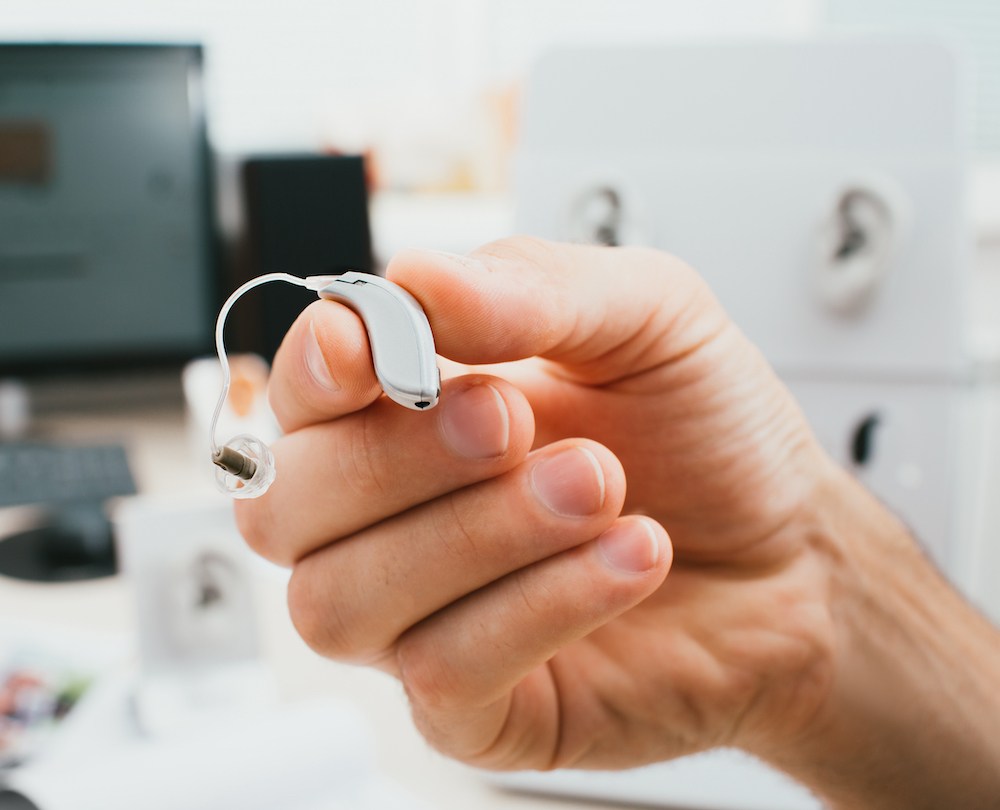Financing Options & Financial Assistance for Hearing Care
Managing hearing loss is an investment in your quality of life, and
Welcome Dr. Aimee Jones to Brentwood Hearing Center! She looks forward to providing expert, compassionate care and warmly welcomes her loyal Vanderbilt University Medical Center patients to join her here.

By: admin | June 24, 2024
Dealing with hearing loss, particularly when it only affects one ear, can seem complicated. This situation, known as unilateral hearing loss, might seem unusual but it’s more common than you might think. Remember, hearing isn’t just about volume; it’s also about direction and clarity. When one ear hears differently than the other, these elements can become distorted, making daily tasks more challenging. By learning more about this topic, you can gain valuable insights into the causes and potential treatments of unilateral hearing loss.
One-sided hearing loss, or unilateral hearing loss, can be a bit puzzling. It’s not as simple as just losing the ability to hear in one ear. Instead, it involves a complex interplay of sound perception and brain processing.
This type of hearing loss can significantly impact your ability to determine where sounds are coming from – a vital skill in everyday life. Not only does this make certain tasks more challenging, but it can also affect your sense of balance and spatial awareness.
However, with the right information and support from audiologists, you can learn to manage this situation effectively. You’re not alone in this; many people live fulfilling lives with one-sided hearing loss every day.
Our ears play a crucial role in sound localization. Our ability to identify where a sound is coming from relies heavily on both ears working together. It’s a bit like a team sport – each ear has its unique part to play.
When both your ears receive sound at the same time, your brain can easily pinpoint its source. This is because it uses the slight differences in when each ear hears the sound to calculate its location. However, if one ear hears differently than the other, as in unilateral hearing loss, this process can get thrown off balance.
Many people experience similar difficulties and have found ways to adapt and overcome them with support from audiologists. Understanding how your ears work together to localize sound is an important step towards managing one-sided hearing loss effectively.
Understanding the factors behind single-ear hearing loss is crucial for effective management and treatment. This condition can stem from various causes, such as injuries, infections or blockages within the ear canal. It may also be associated with specific medical conditions or the use of certain medications.
By recognizing these potential triggers, individuals can collaborate closely with their hearing healthcare provider to assess any existing risk factors and develop a tailored plan for care and treatment. This proactive approach involves comprehensive evaluations, which may include diagnostic tests and medical history reviews to pinpoint the underlying cause accurately.
Once the cause is identified, appropriate interventions can be recommended to address the specific needs of the individual. These interventions may include medical treatments to resolve infections or clear ear blockages, as well as the implementation of hearing aids or other assistive devices to enhance auditory function.
Additionally, understanding the potential causes of single-ear hearing loss enables individuals to make informed decisions about lifestyle adjustments and preventive measures. This may involve strategies to protect hearing from further damage, like using ear protection in noisy environments or monitoring medications that could affect auditory health.
Regular follow-up appointments with healthcare professionals are essential to monitor progress, adjust treatment plans as needed and address any new concerns that may arise. By taking a proactive and informed approach, individuals can optimize their hearing health and improve their overall quality of life.
Ear infections can significantly affect hearing capabilities, particularly when they impact the middle ear. These infections, often caused by bacteria or viruses, lead to inflammation and the accumulation of fluid behind the eardrum. This buildup of fluid can disrupt the movement of the eardrum and the small bones (ossicles) in the middle ear that transmit sound vibrations to the inner ear.
The presence of fluid in the middle ear can result in conductive hearing loss, where sound is not conducted efficiently from the outer to the inner ear. This can cause symptoms such as muffled hearing, difficulty understanding speech or a sensation of fullness in the affected ear.
Treatment for ear infections typically involves antibiotics for bacterial infections or antiviral medications for viral infections as prescribed by your primary care physician. Additionally, your provider may recommend decongestants or antihistamines to reduce inflammation and promote drainage of fluid from the middle ear.
Prompt and appropriate treatment is crucial to prevent complications and minimize the impact on hearing. If left untreated or if infections recur frequently, chronic middle ear infections (chronic otitis media) can lead to persistent fluid buildup and long-term hearing difficulties. This can result in communication challenges and affect overall auditory health in adults. Regular monitoring and follow-up with healthcare providers are important to manage ear infections effectively and preserve hearing function.
Accidents or injuries involving the head can sometimes lead to hearing loss in one ear. This is because such incidents can damage the delicate structures within the ear that are responsible for sound processing.
Trauma-induced hearing loss might not be immediate. It could take days or even weeks for symptoms to appear, making it vital to seek medical attention after any significant head injury. With timely intervention from a hearing specialist, potential damage can be minimized and proper care can be administered.
Understanding the causes behind one-sided hearing loss, including trauma-induced instances, is an important step towards effective management and treatment. Support from professionals and loved ones can make a world of difference as you adapt to life with unilateral hearing loss.
Another potential cause of one-sided hearing loss is acoustic neuroma. This is a noncancerous and usually slow-growing tumor that develops on the main nerve leading from your inner ear to your brain. When an acoustic neuroma grows, it can press against the hearing and balance nerves, often leading to hearing loss in one ear.
Understanding the role of acoustic neuroma in causing unilateral hearing loss is beneficial for several reasons. Firstly, it helps you understand that not all causes of hearing loss are preventable or reversible. Secondly, it highlights the importance of regular check-ups with your audiologist who can detect such issues early on.
While an acoustic neuroma can cause significant changes in your hearing, it’s not a life-threatening condition and there are treatment options available to manage its effects. With knowledge comes power – the power to take control of your health and well-being.
As we grow older, our bodies undergo various changes, and our hearing is no exception. Age-related hearing loss, also known as presbycusis, is quite common and can affect one or both ears.
However, aging doesn’t necessarily mean you’ll experience unilateral hearing loss. While age can be a factor, it’s just one piece of the puzzle. Other factors such as genetics, lifestyle choices and overall health also play significant roles in determining your hearing health.
Stay proactive about your hearing health! Regular check-ups with an audiologist can help monitor any changes in your hearing over time. Don’t wait until you notice a problem – take action today to ensure your ears are in their best shape for years to come!
Recognizing the symptoms of one-ear hearing loss can be your first step towards seeking help and managing the condition effectively.
One of the most common signs is difficulty determining where sounds are coming from. You might also notice a change in your ability to hear conversations in noisy environments or feel like sounds are muffled or distant in one ear.
Recognizing these symptoms early on has several benefits. It allows for timely intervention, which can prevent further hearing loss and improve your quality of life. Additionally, understanding these signs helps you communicate more effectively with your audiologist, leading to more accurate diagnosis and treatment plans.
Single-ear hearing loss is identified through diagnostic procedures. These tests are vital in determining the extent and type of hearing loss you might be experiencing.
The process usually begins with a comprehensive hearing test conducted by an audiologist. This test measures your ability to hear different sounds and pitches in each ear separately. It’s a simple yet effective way to detect any discrepancies between your ears’ hearing capabilities.
If one-sided hearing loss is suspected, further tests may be carried out if the cause isn’t easily recognizable. These could include imaging tests like an MRI or CT scan, which can help identify any physical abnormalities such as tumors or blockages that might be affecting your hearing.
Early detection is key when it comes to managing single-ear hearing loss effectively. By regularly checking in with your audiologist and staying proactive about your ear health, you can ensure that any potential issues are caught early on and treated appropriately.
Treatment options for unilateral hearing loss, where hearing is impaired in one ear, aim to improve hearing abilities and mitigate the impact of hearing loss on daily life. Here are some common approaches:
Experiencing hearing loss in just one ear can present unique challenges. However, with the right understanding and professional support, these challenges can be effectively managed. Many people navigate life with one-sided hearing loss every day.
If you’re noticing changes in your hearing or have concerns about unilateral hearing loss, don’t hesitate to reach out for help. At Brentwood Hearing Center, our dedicated team of audiologists is ready to provide the guidance and care you need. Whether it’s understanding more about why some people experience hearing loss in just one ear or exploring potential treatment options, we’re here for you.
You can contact us at our Nashville location at (615) 866-0431 or visit us at our Brentwood location. Let’s work together towards better understanding and managing your hearing health because every sound matters.

Managing hearing loss is an investment in your quality of life, and
By: admin | October 20, 2025

Water used to be a major challenge for hearing aid wearers. A sudden
By: admin | July 29, 2025

Most people think of hearing tests as something you do when you’re
By: admin | June 20, 2025
Schedule an appointment today with one of our Doctors of Audiology. We’re ready to assist you on your journey to better hearing!
